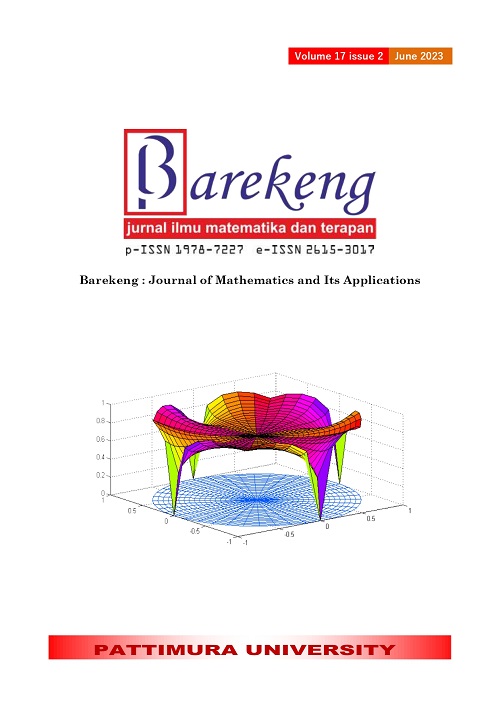APPLICATION OF THE COPULA METHOD TO ANALYZE THE RELATIONSHIPS OF MACROECONOMIC FACTORS AFFECTING THE CSPI
Abstract
The Composite Stock Price Index (CSPI) is a valuable number in assessing the performance of the stocks listed on the stock exchange; by looking at the Composite Stock Price Index, investors can determine their investment strategy. However, the rise and fall of the Composite Stock Price Index depend on a country's macroeconomic conditions; if the economy weakens, the company's performance will also undermine investors' confidence, and confidence decreases. Analysing the relationship between the Composite Stock Price Index with macroeconomic factors can show how much the influence of these factors on the increase or decrease in the Composite Stock Price Index, the macroeconomic factors in question are inflation, interest rates and the rupiah exchange rate. In this study, dependency analysis was carried out with the Copula approach method involving the Tau Kendal method for parameter estimation and the Maximum Likelihood Estimation (MLE) method to choose the best Copula model to explain the relationship between the Composite Stock Price Index and these macroeconomic factors. Research results in it are found that the best Copula that can explain the dependency structure between the Composite Stock Price, The index with inflation and interest rates is the Gumbel Copula with parameters θ ̂= 1.264 and θ ̂= 1.174, While the Copula model is the best that can explain the structure of the dependency between Composite Stock Price Index and the exchange rate is Copula Student-t with parameter θ ̂= −0.6037.
Downloads
References
Sunariyah, Introduction to Capital Market Knowledge , Third. Yogyakarta: UPP AMPYKPN, 2013.
P. Nano, and Putra, B. A, “The Factors Affecting the Composite Stock Price Index (CSPI) of Indonesia Stock Exchange”, Jurnal Ekonomi & Studi Pembangunan, vol.21, no. 1, 2020, pp. 69-83
B. Setianto, Fair Value Stock Investment (Value Investing) . Jakarta: Bumisaka Kurnia, 2014.
P. Embrechts, "Copulas: A Persolan View," J. Risk Insur. , vol. 76, no. 3, pp. 639–650, 2009.
J. Segers, “Asymptotics of empirical copula processes under non-restrictive smoothness assumptions”, Bernoulli, vol 18, no. 3, 2012, 764–782
OW Ningrum, Tarno, and DAI Maruddani, "Calculation of Value At Risk in Stock Portfolios Using Copula," J. Gaussian , vol. 6, no. 2, pp. 231–240, 2017, [Online]. Available: https://ejournal3.undip.ac.id/index.php/gaussian/article/view/16952/16249
J. Segers, M. Sibuya, & H. Tsukahara, “The empirical beta copula”, Journal of Multivariate Analysis, vol. 155, 2017, pp. 35–51
J. Chvosta, DJ Erdman, and M. Little, “Modeling Financial Risk Factor Correlation with the COPULA,” Stat. Anal Data. , pp. 1–14, 2011.
S. Wati, M. Hadijati, and N. Fitriyani, "Dependency Analysis of Macroeconomic Factors on the Gold Price Level," Eig. Math. J. , vol. 2, no. 2, 2019.
K. Valentovičová, “Claim Reserving With Copulae For Multiple Line of Business.” Master Thesis. Charles University in Prague, 2015.
Y. Wilandari, SH Kartiko, and AR Effendie, "Estimation of Reserve Claims Using Generalized Linear Model (GLM) and Copula," J. Gaussian , vol. 9, no. 4, pp. 411–420, 2020.
QR Sartika, T. Widiharih, and MA Mukid, “Value at Risk in Stock Portfolio Using t-Copula: Case Study of PT. Indofood Makmur, Tbk. and Bank Mandiri (Persero), Tbk.,” J. Media Stat. , vol. 12, no. 2, pp. 175–187, 2019.
Q. Zhang, V. . Singh, J. Li, F. Jiang, and Y. Bai, “Spatio-temporal Variations of Precipitation Extremes in Xinjiang, China,” J. Hodrology , vol. 434–435, pp. 7–18, 2011.
C. Genest and J. Neslehova, Copulas: Introduction to the Theory and Implementation in R with Applications in Finance and Insurance . Canada: University Laval and McGill University, 2010
Pevšta, M. dan Okhrin, O. 2014. Conditional Least Squares and Copulae in Claims Reserving for a Single Line of Business. Journal of Insurance: Mathematics and Economics. Volume 56, 2014, pp. 28–37.
C. Barbara, I. Rustam, and P. Elena, “Copula Estimation,” in In Copula Theory and Its Application , Lecture Notes in Statistics, 2011, pp 93-109
Copyright (c) 2023 Sri Endang Saleh, Debyyansa Pakaya, Irsan K. Hasan, Ismail Djakaria

This work is licensed under a Creative Commons Attribution-ShareAlike 4.0 International License.
Authors who publish with this Journal agree to the following terms:
- Author retain copyright and grant the journal right of first publication with the work simultaneously licensed under a creative commons attribution license that allow others to share the work within an acknowledgement of the work’s authorship and initial publication of this journal.
- Authors are able to enter into separate, additional contractual arrangement for the non-exclusive distribution of the journal’s published version of the work (e.g. acknowledgement of its initial publication in this journal).
- Authors are permitted and encouraged to post their work online (e.g. in institutional repositories or on their websites) prior to and during the submission process, as it can lead to productive exchanges, as well as earlier and greater citation of published works.






1.gif)



